1750-1771 Richard Vernon
Richard Vernon, son of the MP for Staffordshire Henry Vernon, was born at Hilton Park, Staffordshire on 18th June 1726. After completing his education, he undertook the Grand Tour of Italy and France in 1743 before joining the Army in November 1744. He was promoted to Captain in 1747, but by 1750 he began devoting a great deal of his time pursuing his sport of horse racing, although on 10th December 1754 he was elected as Member of Parliament for Tavistock. In one of the earliest detailed maps of Newmarket, issued in 1768, Richard Vernon was shown as the owner of the present day Cadland Stables, although at that time it was known as Stebbings. What is known is that part of Cadland, the north stable block, is one of the oldest surviving buildings associated with any Newmarket racing stable. It is shown on a painting by Peter Tillemans from 1725 called, 'A panoramic view of Newmarket from Warren Hill'. The house and stables were built later in the 18th century and are in a prime location at the foot of Warren Hill. Richard Vernon owned and bred a large number of horses, and it seems likely that he owned Cadland as early as 1750, because he was one of the original members of the Jockey Club and, as early as 4th June 1751 an ancient betting-book at the 'old White's Club' records a wager between Captain Richard Vernon and Lord March. In the race Vernon's chestnut horse by Partner defeated Lord March's chestnut gelding by Fletchers Vane Arabian over 4 miles to land the 50 guineas wager. Later, when Vernon was fully established in Newmarket, he struck up a partnership with Lord March. In 1753 he won two Jockey Club Plates, while in April 1757 he won the King's 100 Guineas Stakes with Forester at Newmarket. He repeated that victory in April 1765 with Virago, also winning a further Jockey Club Plate in the same year with Banker. One of his most important victories at Headquarters was in 1768 when he won the first Jockey Club Challenge Cup with Marquis, a son of one of the founding thoroughbreds, the Godolphin Arabian, buried at Wandlebury Hill, a few miles south-east of Cambridge. Whilst it is not certain, it is likely that he had sold Cadland to the 3rd Duke of Grafton by 1771, for he bought a 60-year lease of Newmarket Coffee-House from the Jockey Club in that year. One of his highest profile runners was Fame, who gained fame as runner-up to the Earl of Derby's Bridget 5/2 (SR 1971) in the very first Oaks in 1779. He went one better in 1787 by winning the Epsom Oaks with Annette at 6/4 (SR 1993). Richard Vernon continued to ride when he was 70, but died on 16th September 1800.
4th June 1751 Match at Newmarket Unnamed horse by Partner, owned by Captain Vernon, beat Unnamed horse by Fletchers Vane Arabian owned by Lord March
30th September 1751 £40 Subscription Purse at Newmarket, BEAU, owned by Captain Vernon, beat Lord Gower’s Jubilee Dick
14th April 1757 King's 100 Guineas Plate FORESTER, owned by Mr Vernon
12th April 1765 King's 100 Guineas Plate VIRAGO owned by Mr Vernon
30th April 1765 Jockey Club Plate (100 Guineas) BANKER owned by Mr Vernon
11th July 1765 200 Guineas Sweepstake OTHO owned by Mr Vernon
1787 Epsom Oaks ANNETTE 6/4 (SR 1993) owned by Richard Vernon, trained by J Watson and ridden by Dennis Fitzpatrick
NEWMARKET RACECOURSES
For over 4 centuries racing has been staged in Newmarket, but how have the racecourses evolved from an initial starting point at Fleam Dyke Pumping Station, some 8 miles from the town, with a winning post barely 200 metres from the town centre, into two world recognized, excellent racecourses and a universal acceptance that Newmarket is the Headquarters of racing?
To access an interactive racecourse map showing over 50 individually named racecourses CLICK HERE. The map will enable you to:-
1. Determine when extended races over 8 miles, 6 miles and 4 miles began to be replaced by the courses now visited by thousands annually;
2. Consider how the challenge of crossing the Devil's Dyke was overcome;
3. Contemplate why the town no longer has a steeplechase course despite having at least 5 courses during the past 2 centuries;
4. Examine the practicalities of having up to 48 starting posts and winning posts;
5. Appreciate that it was not financially viable to have an open racecourse spread widely across the heath, with a finishing post barely 200 metres from the town centre;
6. Research how and why the Cambridgeshire Handicap has been contested over 3 different courses.
NOTE: The map does not make mention of 2 particular courses:-
(i) Sefton Course (also known as the Cambridge Road Course)
Source: 1970 Raceform.Used from 1959 to 1975.
(ii) New Circular Course
The Circular Handicap was run on Friday 29th October 1875 on the New Circular Course of about two miles.
Source: London Standard (30th October 1875): ''the horses started near the Turn of the Lands, ran back way of the Cambridgeshire Course towards the Ditch, and afterwards proceeded down the side of the Tan Gallop, and turned into the Rowley Mile near the Bretby Stakes starting post, finishing at the stand at the end of the flat. Except in the hollow near the Cambridgeshire start the runners should have been visible all the way if the sky had been bright and clear''.
Another report hoped that the Circular Handicap would become a feature in future programmes, as it would be contested in front of the new grandstand which would be completed in about a year and would be able to accommodate thousands.
(I am grateful to Tim Cox for bringing attention to these 2 courses.)
Enjoy researching the intriguing history of Newmarket and its many racecourses.
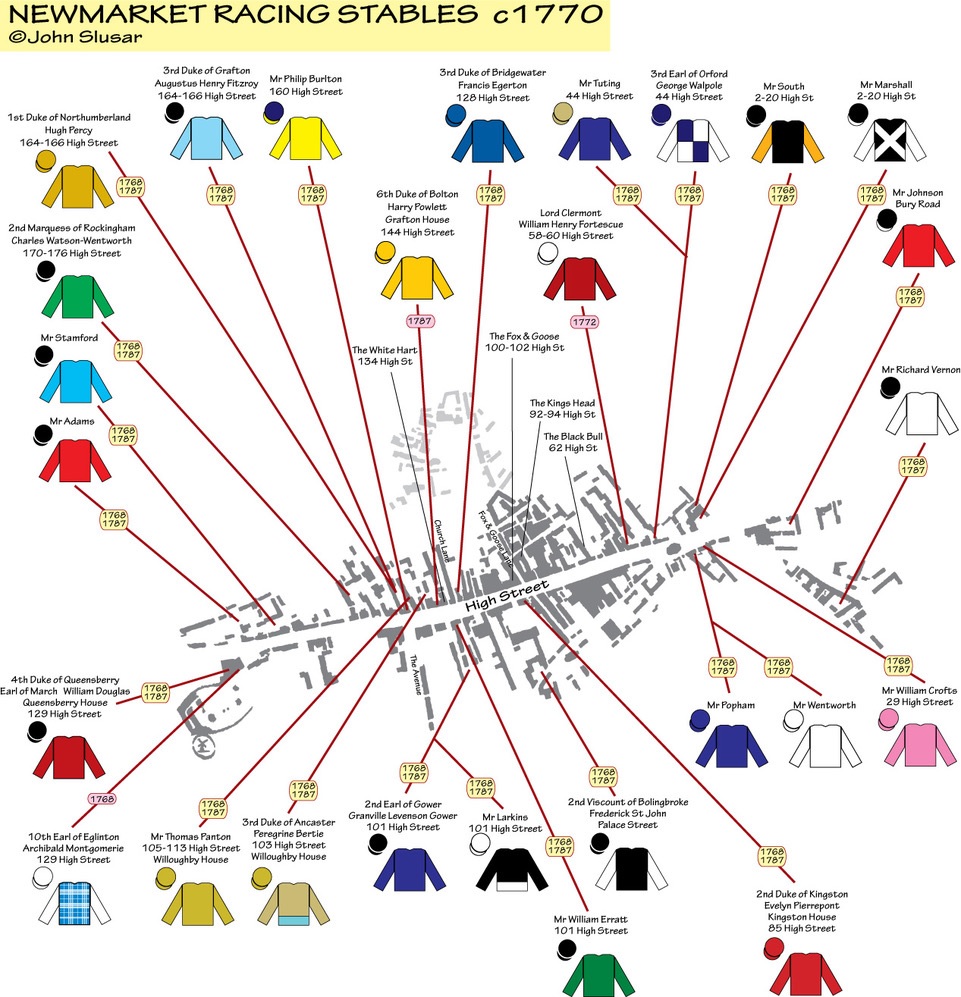
1771-1811 3rd Duke of Grafton
Augustus Henry Fitzroy, son of Lord Augustus Fitzroy, was born on 28th September 1735 and was educated at Westminster School and Peterhouse College, Cambridge. Between 1747 and 1757 he liked to be known as the Earl of Euston, and he became an MP in 1756, representing the Whigs in Boroughbridge. When his father died in 1757 he inherited the title the 3rd Duke of Grafton, while on 14th October 1768 he became Prime Minister at just 33 years of age. In maps of 1768 and 1787 the Duke had stables at 164-166 High Street, but also had an interest in other Newmarket stables. Indeed, his 1802 Derby winner Tyrant was trained by Robert Robson at Kingston House, Newmarket. The Duke also owned a stud in Suffolk at the ancestral home, Euston Hall. His racing colours, sky blue with black cap, were carried to victory in 5 English Classics, including Derby wins in 1802 with Tyrant, in 1809 with Pope, and the next year with Whalebone. The Duke died on 14th March 1811, the title and his estate passing to his son George Henry Fitzroy.
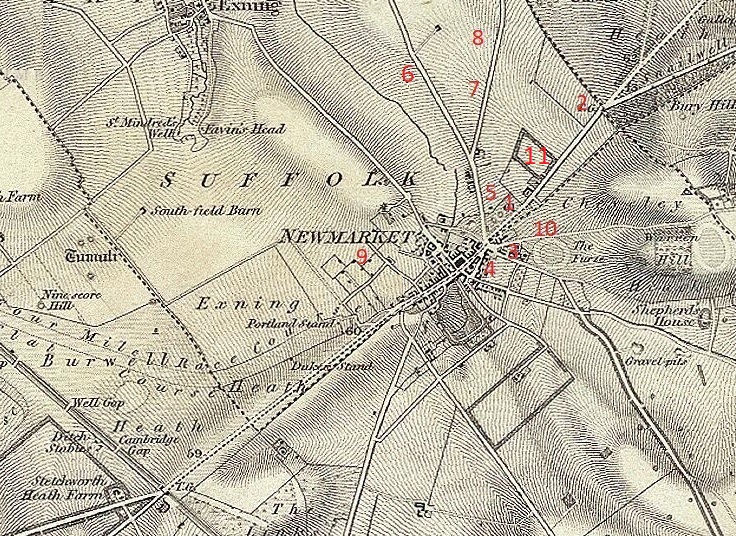
Horses trained by Robert Robson at Kingston House
1802 Epsom Derby TYRANT 7/1 (SR 1984) owned by 3rd Duke of Grafton, trained by Robert Robson and ridden by Frank Buckle
1804 Epsom Oaks PELISSE 4/5 fav (SR 1995) owned by 3rd Duke of Grafton, trained by Robert Robson and ridden by Bill Clift
1808 Epsom Oaks MOREL 3/1 (SR 1954) owned by 3rd Duke of Grafton, trained by Robert Robson and ridden by Bill Clift
1809 Epsom Derby POPE 20/1 (SR 1969) owned by 3rd Duke of Grafton, trained by Robert Robson and ridden by Tom Goodisson
1810 Epsom Derby WHALEBONE 2/1 (SR 2077) owned by 3rd Duke of Grafton, trained by Robert Robson and ridden by Bill Clift
1811-1827 4th Duke of Grafton
George Henry Fitzroy, son of the 3rd Duke of Grafton, was born in London on 14th January 1760 and was educated at Harrow School and Trinity College, Cambridge. He became the MP for Thetford in 1782, two years later becoming MP for Cambridge University. He inherited the title of 4th Duke of Grafton on the death of his father on 14th March 1811, also inheriting his father's love of racing. In addition to owning stables at 164-166 High Street, he continued to employ the same trainer as his father, Robert Robson, who was based at nearby Kingston House stables. Many of the Classic winners trained by Robert Robson were sent out from Kingston House.
1813 Epsom Oaks MUSIC 5/2 (SR 1953) owned by 4th Duke of Grafton, trained by Robert Robson and ridden by Tom Goodisson
1815 Epsom Oaks MINUET 3/1 (SR 1968) owned by 4th Duke of Grafton, trained by Robert Robson and ridden by Tom Goodisson
1815 Epsom Derby WHISKER 8/1 (SR 1969) owned by 4th Duke of Grafton, trained by Robert Robson and ridden by Tom Goodisson
1819 1000 Guineas CATGUT 20/1 (SR 1782) owned by 4th Duke of Grafton, trained by Robert Robson and ridden by Frank Buckle
1820 1000 Guineas ROWENA 7/4 (SR 1892) owned by 4th Duke of Grafton, trained by Robert Robson and ridden by Frank Buckle
1820 2000 Guineas PINDARRI Evens fav (SR 1988) owned by 4th Duke of Grafton, trained by Robert Robson and ridden by Frank Buckle
1821 1000 Guineas ZEAL 4/6 fav (SR 1907) owned by 4th Duke of Grafton, trained by Robert Robson and ridden by Frank Buckle
1821 2000 Guineas REGINALD 11/10 (SR 1987) owned by 4th Duke of Grafton, trained by Robert Robson and ridden by Frank Buckle
1822 1000 Guineas WHIZGIG 2/5 (SR 1969) owned by 4th Duke of Grafton, trained by Robert Robson and ridden by Frank Buckle
1822 2000 Guineas PASTILLE 4/6 fav (SR 2015) owned by 4th Duke of Grafton, trained by Robert Robson and ridden by Frank Buckle
1822 Epsom Oaks PASTILLE 7/2 (SR 2015) owned by 4th Duke of Grafton, trained by Robert Robson and ridden by Harry Edwards
1823 1000 Guineas ZINC 4/6 fav (SR 1999) owned by 4th Duke of Grafton, trained by Robert Robson and ridden by Frank Buckle
1823 Epsom Oaks ZINC Evens fav (SR 1999) owned by 4th Duke of Grafton, trained by Robert Robson and ridden by Frank Buckle
1825 1000 Guineas TONTINE (SR 1767) owned by 4th Duke of Grafton walked-over
1826 1000 Guineas PROBLEM 5/1 (SR 1830) owned by 4th Duke of Grafton, trained by Robert Robson and ridden by John Barham Day
1826 2000 Guineas DEVISE 7/2 (SR 1955) owned by 4th Duke of Grafton, trained by Robert Robson and ridden by Frank Buckle
1827 1000 Guineas ARAB 8/1 (SR 1813) owned by 4th Duke of Grafton, trained by Robert Robson and ridden by Frank Buckle
1827 2000 Guineas TURCOMAN 5/1 (SR 1986) owned by 4th Duke of Grafton, trained by Robert Robson and ridden by Frank Buckle
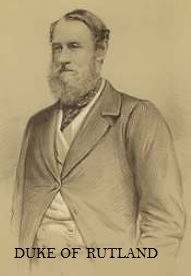
1828-1857 5th Duke of Rutland, Richard Dixon-Boyce
John Henry Manners, eldest son of Charles Manners, the 4th Duke of Rutland, was born at Knightsbridge on 4th January 1778. He was an extensive landowner, but his passion was for horse racing, and he became a successful owner and breeder. He inherited the title 5th Duke of Rutland on the death of his father in 1787, and later became Lord Lieutenant of Leicestershire. The fanily also owned the Cheveley Park Estate. Cheveley Castle was built in 1341 by Sir John de Pultenay. The estate later came into the ownership of Sir Henry Jermyn in 1650 and it was he who built the first Cheveley Park mansion. In the early years of the 18th century, between 1730 and 1740, the Estate was taken over by the Duke of Somerset, but by 1750 the Dukes of Rutland had gained ownership. It was the 5th Duke of Rutland who established Cheveley Park as his stud, and it was he who planted a tree lined avenue as a lasting memorial to his wife, naming it the Duchess Drive. At the Stud he bred 4 Classic winners, the first of which was the 1811 Epsom Oaks winner Sorcery. Three years later he won the Oaks again with the home-bred filly Medora. At some point in the early years of the 19th century he purchased the House and Stables known at that time as Stebbings which were ideally situated at the foot of Warren Hill. In 1828 the Duke of Rutland won the 2000 Guineas and Derby with another home-bred colt, Cadland, although Cadland only won the Derby outright in a run-off, having dead-heated first time around. In theory, he is the only horse in history to have won the Epsom Derby twice. Sometime after that victory the stables and House he had purchased were named Cadland in honour of the horses two Classic wins. The Duke died at his Belvoir Castle home on 20th January 1857.
1814 Epsom Oaks MEDORA 10/1 (SR 1875) owned by 5th Duke of Rutland, trained by Richard Dixon Boyce and ridden by Sam Barnard
1816 1000 Guineas RHODA 3/1 (SR 1875) owned by 5th Duke of Rutland, trained by Richard Dixon Boyce and ridden by Sam Barnard
1828 2000 Guineas CADLAND 5/2 (SR 2016) owned by 5th Duke of Rutland, trained by Richard Dixon Boyce and ridden by Jem Robinson
1828 Epsom Derby CADLAND 4/1 (SR 2016) owned by 5th Duke of Rutland, trained by Richard Dixon Boyce and ridden by Jem Robinson
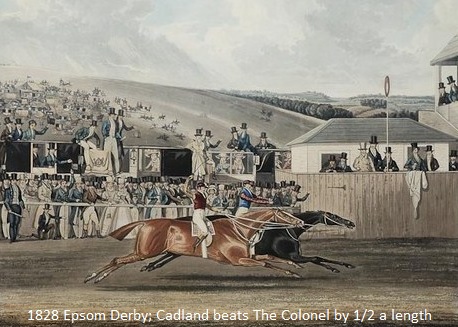
CADLAND (1825-1837)
Cadland, a brown horse by Andrew out of Sorcery, was foaled in 1825 at the Duke of Rutland's Stud. His dam, Sorcery (SR 1937) won the 1811 Epsom Oaks, although his sire, Andrew, did not distinguish himself on the racecourse. Nevertheless, in a career spanning 27 races, Cadland won 17, including the 1828 2000 Guineas at 5/2, having previously won at the Craven meeting when known simply as 'The Sorcery colt', following up in the Produce Stakes a few days later. In the 1828 Epsom Derby Cadland (SR 2016), ridden by Jem Robinson, dead-heated at 4/1 with The Colonel. However, as was common in those days, there was a run-off and, despite being the outsider at Evens with The Colonel offered at 4/5 fav, Cadland won by half a length. His owner, the Duke, spared him the journey to Doncaster for the St Leger, giving The Colonel the chance for a Classic victory, but he ran in the Newmarket St Leger which he won in a canter, having previously won the Grand Duke Michael Stakes at Newmarket. Kept in training as a four-year-old, he was beaten in his first run of the season, but later claimed victories in the Oatland and Audley End Stakes. The next year he won the Jockey Club Plate and the demanding, historic 4 mile 'Newmarket Whip' initiated by King Charles II. At stud he had limited success in England, but did sire Romulus, the 1839 winner of the Prix du Jockey Club.
January 1874-July 1921 William Henry Manser
William Henry Manser, born in 1836, was apprentice to Richard Drewitt at Lewes before departing for Egypt to take charge of the racing stud of Ismail Pacha. He then began training for a number of prominent and important foreign dignitaries. These included the Emperor of Russia, the Sultan and the Khedive, His Highness the Viceroy of Egypt. When he returned to England, in August 1869, he based himself at Newmarket where he purchased bloodstock to send to J Stone's Stud in Moscow. He had a trainer's license by 1870 and was training his own horses in Newmarket, although it was not until 5th January 1874 that he purchased Cadland House Stables, which were previously known as 'Stebbings'. Just a fortnight later, on 17th January 1874 he married Marie Catherine Wilson, only daughter of General George Wilson from Shrewsbury, at St George's Church in Hanover Square. At that point in time Cadland adjoined the stables of C Blanton. He started off with a small string, and even two years later, in 1876, he had only 14 horses, 4 of his own, 5 for J R Wilson and 5 for J Johnson. Although there is no evidence of victories in important races early in his career, by 1878 his string had increased to 42 horses. Furthermore, he oversaw the development of a number of apprentices who later became household names. His principal stable jockey in 1875 was his son John, riding at 7st 12lbs, but George Barrett was also at Cadland at that time, riding his first winner in September 1877 aboard Titania at Kingsbury Racecourse. Manser was a firm disciplinarian which more than once got him into trouble. In 1880 he was in court charged with assaulting stable jockey John Wheeler on 31st July, while in February 1881 he was convicted of a further offence, assaulting the light-weight jockey Fred Barrett, cutting his head open with a 'flying' saucer. Fred, the younger brother of George Barrett, was born on 21st October 1867 at Nut Tree, Metfield, Suffolk and was apprentice to Manser at Cadland for 4 years before moving to W L'Anson's Stable at Langton Wolds. Manser was an accomplished trainer for over 40 years, saddling 134 winners in his best season, but he also developed a side business, exporting bloodstock to a number of countries, and had his own stable at Buenos Aires whilst still based at Cadland. Manser seldom won valuable races, a fact regularly reported in the sporting newspapers. In 1908 the Sporting Life commented, 'Some trainers never appear to receive their fair share of patronage, a case in point furnished by the record of William Manser who, although year after year turns out one or two useful winners from a small string, rarely has his boxes full. At present he has room for 50 horses in a yard which opens directly onto the Heath, but in 1907 he ran just two horses, Morgendale and Larkfield. The former won two handicaps, the latter ran six times without victory'. Manser was still saddling horses at the end of the War in 1918, although by then it might well have been son John who was overall in charge. In the latter part of 1920 he became ill, and died in July 1921. His funeral took place on Monday 25th July 1921, attended by three of his sons, John, Charles and Roland, and his two daughters Edith and Queenie, and his remains were laid to rest in Newmarket cemetery. His other son, George, who trained the 1919 2000 Guineas winner The Panther whilst training at Warren House Stables, became a trainer in Spain at the time of his father's death and does not appear to have attended the funeral.
July 1921-1939 John Manser
John Manser took over Cadland House and Stables on the retirement of father William, and when his father died in 1921 John was certainly in charge. John was not as enterprising as his father had been, as both he and his father struggled to make a living from training, but William had also developed his sideline of selling bloodstock abroad. John subsequently advertised the 46-box stable and house 'For Sale or To Let' in 1923. In April 1925, with Cadland still not sold, John Manser had just one horse in his stable, Attraction, which he subsequently sold to Mr Connelly for 600 guineas. He still had not sold it by 1937 for, on Monday 18th January 1937 a fire broke out at St Gatien Stables, owned by Robert Sherwood, in the very early hours of the morning. Part of the stable was leased by Captain Whitaker, and the other part by Mr Beedle, but the police arrived and had to break the locks on stable doors to release the horses which then galloped through the town. A number of horses were caught by stablehands, but others ran far and wide into the countryside, reaching Saxon Street, Snailwell and Exning. At the time of the fire 25 horses were stabled at St Gatien, many of which were immediately accommodated by John Manser in his empty Cadland House Stables. John Manser continued to live in Newmarket after his retirement, and died, aged 80, on Monday 17th December 1956.
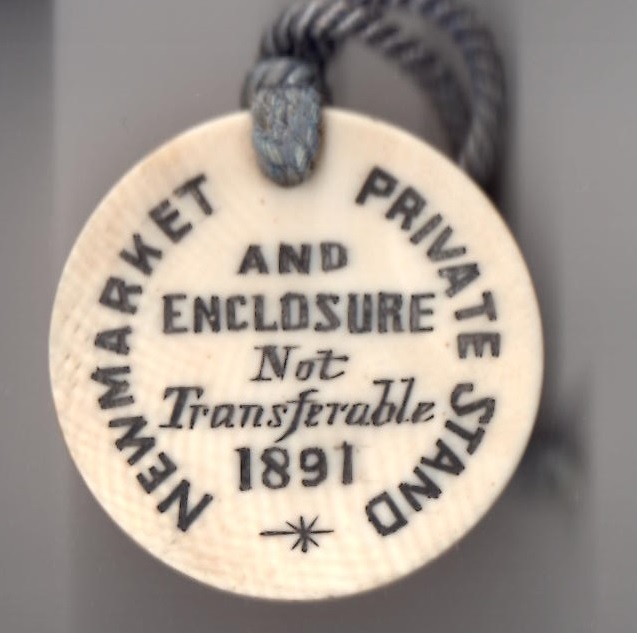
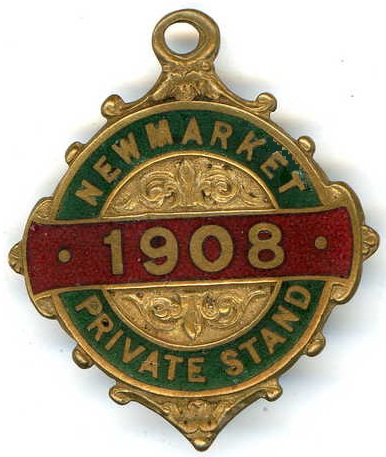
1938-1939 Ryan Jarvis
Ryan Jarvis was born into a well-established racing family, serving his apprenticeship with father Willie before moving on to gain further experience with his uncle, Fred Butters, at Kingsclere. Willie Jarvis had purchased Marlborough House in the mid-1930s with a view to using it as his retirement home, enabling Ryan to launch his training career from that base in 1936. Ryan trained his first winner Alexdream 4/11 fav, owned by Colonel H E Hambro and ridden by Harry Blackshaw, at Birmingham on Monday 2nd November 1936. Ryan is also thought to have taken over some boxes at Cadland just before the outbreak of War, because newspaper reports suggested that when Fred Butters moved from Kingsclere to Cadland in 1939 he was taking over boxes vacated by Ryan. Ryan was called up to active service in the Grenadier Guards, resuming his training career in 1946 at Clarehaven Lodge.
1939-1950 Fred Butters
Fred S Butters was born into a racing family on 3rd December 1887, his father Joseph trained in Austria and Newmarket, while his brother Frank was extremely successful, training 16 Classic winners. After his school days were over Fred began training in Austria until the First World War disrupted his career. He was interned during the War, and then was Assistant to his father in Newmarket immediately after the War had ended. However, in 1924 he leased Beverley House Stables from his brother-in-law, while in 1927 he took over the lease at Heath House Stables, although within a year he suffered a setback when, in April 1928, Mr Foxhall P Keane announced his retirement from racing, having enjoyed limited success with the horses he had sent to Fred Butters at Heath House. Fred stayed at Heath House until 1934 before moving to the Kingsclere stables of Captain Wills. It was whilst he was there that he trained the runner-up Ankaret in the 1935 Oaks, beaten only a short head by Quashed (SR 1922), but two years later he reached the pinnacle of his career, training 1937 Epsom Derby winner Mid-day Sun (SR 1954) owned by Mrs Lettice Miller. In 1939 Kingsclere closed when War broke out, so Fred moved back to Newmarket to take over at Cadland House Stables, filling some of the stables previously occupied by his nephew Ryan Jarvis before he joined the Army. Whilst he was at Cadland he was unable to repeat the Classic success he had at Kingsclere, but was viewed as a conscientious trainer who achieved a considerable measure of success considering the class of horse which he regularly had in his stable. In 1950, aged 62, he followed brother Frank into retirement, the last of the Butters to train in Newmarket, and died 17 years later in August 1967, and was replaced at Cadland by Alec Waugh.
1950-1956 Alec Waugh
Alexander Ernest Waugh, more commonly known as Alec, was the son of Richard Waugh who trained in Germany for the Kaiser, and nephew to Dawson and Tom Waugh, training a string of 40 horses in Germany before the First World War, but once the War broke out he was interned at Ruhleben. At the end of the War Alec returned to Newmarket, joining Tom Waugh at Meynell House until 1925 when, in the 1925 season, he trained 8 jumpers at Osborne House. The horses included Mr Reg Day's Mentagne, Mr Dawson Waugh's Malpas and Lt-Colonel Leake's Starosta. He married in 1926 and returned to Germany, initially at Dusseldorf and then onto Cologne. He became private trainer to Baron Alphonse de Rothschild, who was based in Oberweiden, Vienna, but had to return to England prior to the outbreak of the Second World War due to the increasing threat from Hitler. He was appointed headman for Charlie Peck at Foxhill and Cowie at Tarporley, also spending some time with Frank Butters at Fitzroy House. By the mid-1940s he was training in his own right at Marlborough House before moving to Cadland Stables in 1950, remaining there until replaced by Arthur Goodwill in 1956. During his time at Cadland Stables his most successful horse was Kelling, winner of the 1950 Cambridgeshire, Esher Cup and Britannia Stakes at Royal Ascot. He also trained Kesrullah to success in the Coronation Day Stakes. Famously, when Kelling won the Cambridgeshire in 1950, partnered by Doug Smith, Lester Piggot, then a 14-year-old, was aboard the runner-up Zina, but rode his horse back into the winners enclosure.
1950 Esher Cup at Sandown KELLING (17/2) owned by Chris Jarvis, trained by Alec Waugh and ridden by Ray Reader
1950 Britannia Stakes at Royal Ascot KELLING (100/8) owned by Chris Jarvis, trained by Alec Waugh and ridden by Ray Reader
1950 Cambridgeshire at Newmarket KELLING (100/7) owned by Chris Jarvis, trained by Alec Waugh and ridden by Doug Smith
1953 Coronation Day Stakes at Kempton KASRULLAH (3/1 fav) owned by Alec Bird, trained by Alec Waugh and ridden by Manny Mercer
1956-1978 Arthur Goodwill
Arthur William Goodwill was born on 17th December 1911 at Oswaldwistle, Lancashire. Although not born into a racing family, he became an apprentice to Harvey Leader in 1926 where he earned the nickname 'fiddler'. This had nothing to do with his racing antics, but everything to do with his ability with a violin. He had limited success as a jockey, initially over the Flat with Harvey Leader, and later over jumps with Tom Leader when he became heavier. He spent the War working with radios, whilst at the same time moonlighting as Manager at a Cambridge Night Club, but as soon as the War had ended he launched his training career at Royston. From there he moved to Balsham in 1946, while in 1954 he rented Sackville House Stables from Jack Jarvis, later purchasing that racing establishment. In 1956 he purchased Cadland House and Stables, even using it as an overflow yard when his neighbouring Sackville House Stables was full. In the mid-1950s, and again on two occasions in the mid-1960s, his string exceeded 30, so he may well have needed the additional boxes. A number of sources between 1956 and 1978 suggest that Cadland was leased by Goodwill to a range of up and coming trainers. In January 1970 it is reported that Cadland was leased to Reter Robinson from Goodwill, while 2 years later Michael Stoute had just been allocated his licence to train, and leased Cadland at the start of the 1972 season before moving on to Beech Hurst in 1973. On 12th September 1972 a newspaper reported that Brian Lunness would take over Cadland for the 1973 season, although the deal did not go ahead, Lunness moving instead to La Grange, Machell Place and Cheveley Park Stables. In 1975, newspaper sources suggest that Neville Callaghan, then based at Amberley House on the Bury Road, leased Cadland, for his lads turned up there for work to be met by pickets in May 1975, but Cadland was certainly the home of new trainer Dicke Westbrook in 1975 during that strike. In all likelihood, it was Arthur Goodwill who eventually sold Cadland to Mick Ryan in 1978. Goodwill was a likeable character who seemed to make something out of nothing, recording his best season in 1961, notching up 22 winners, 18 seconds and 11 third placed horses, and a year later he landed the Princess Mary Nursery at Doncaster with Vent Neurf. Arguably his greatest success was winning the 1969 Bunbury Cup with Woolley. During his time at Cadland Stables he realised that the stables and grounds had been frequently used for cockfighting in the early years of the 19th century, and that the outlines of 3 cockpits remained, which Goodwill used as dunghills. Very close to Cadland Stables, on Sackille Street, which up to 1959 had been called Shagbag Alley due to its connections with cockfighting, was Boyce House which boasts a history dating back to 1690. In the gardens of Boyce House to this day remains a cockpit, although it is covered over by the current owners. Goodwill retired at the end of the 1981 season, and died aged 82 on 22nd November 1994, and is buried in Newmarket Cemetery.
January 1970-January 1972 Peter Robinson
Peter John Robinson, son of a Nottingham based interior decorator, was born at Kimberley on 13th June 1936 and, after completing his statutory education became apprentice to Harry Wragg at Abington Place. He was crowned champion apprentice in 1955, riding 46 winners in that season, having secured his first winner on Prince Yaky at Birmingham racecourse on 22nd June 1952 aged 16. He was a go-to lightweight rider in Handicaps, sometimes riding as low as 7st, winning the 1955 Ebor Handicap on Hyperion Kid and the Cambridgeshire in the same year, riding Lady Zia Wernher's Retrial at 18/1. In 1957 he was aboard Retrial again in the Royal Hunt Cup which he won at 100/7 for Wernher and Cecil Boyd-Rochfort. He won the first of 3 Lincoln Handicaps in 1959 on Marshal Pil (15/2), winning again in 1964 on Mighty Gurkha (33/1), and yet again in 1967 on Ben Novus (22/1). In August 1969 trainer Edward (Teddy) Lambton decided to call it a day for the second time at Kremlin House Stables, leaving Peter with the decision of whether to continue to ride or to embark on a training career. He chose the latter and made an immediate success of it by landing the Cambridgeshire with Prince de Galles at 5/2 favourite, carrying only 7st 12lbs. Peter trained at Kremlin House for the final 3 months of the season, doing so well that he earned a place in the jockeys and trainers tables. Teddy sold Kremlin House and Stables to Jeremy Hindley in time for the 1970 season, leaving Peter Robinson to lease Cadland House Stables from Arthur Goodwill, moving his string of 29 horses in readiness for the start of the 1970 season. It is clear what a good thing Prince de Galles was in the 1969 Cambridgeshire with only 7st 12lbs, for he won the race the next year carrying 9st 7lbs. In the 1971 season Peter's string had increased to 41, while in January 1972 Peter was enticed away from Cadland by Messrs Jack and David Fisher, patrons of Peter at Cadland, who purchased Fitzroy House Stables from Sir Robert McAlpine.
1969 Cambridgeshire PRINCE DE GALLES 5/2 fav owned by Mr A Swift, trained by Peter Robinson and ridden by Frankie Durr
1970 Cambridgeshire PRINCE DE GALLES 6/1 owned by Mr A Swift, trained by Peter Robinson and ridden by Frankie Durr
1972 Lincoln Handicap SOVEREIGN BILL 9/2 fav owned by Mr W Barr, trained by Peter Robinson and ridden by Edward Hide
1972 Sir Michael Stoute
Michael Stoute, whose father was Chief of Police for Barbados, was born on the island on 22nd October 1945. After completing his schooling, he travelled to England to join Pat Rohan's stable as his assistant in 1964, remaining in post for the next 8 years. In 1972 he took a licence to train in his own right, leasing Cadland House Stables for his string of 15 horses from Arthur Goodwill for the 1972 season before moving on to Beech Hurst Stables with 32 horses in 1973 and, from there, taking over at Freemason Lodge from Henry Cecil. Within a few days of the start of the 1972 season he had trained his first Flat winner Sandal, owned by his father Ronald, who won at Newmarket on 28th April 1972.
1972 Turn of the Lands Handicap at Newmarket SANDAL 7/2 owned by Ronald Stoute, trained by Michael Stoute and ridden by Lester Piggott
1974-1977 Dickie Westbrook
Richard 'Dickie' Westbrook, born in New Cross, London on 26th July 1927, was a proud Cockney who spent all of his working life in racing, arriving in Newmarket as a 5st 4lb lad, working his way up to Head Lad for Jack Watts via the post of Travelling Head Lad. In 1974, aged 47, he decided to launch his own training career at the 25-box Cadland Stables, winning 3 races in his first season, but also guiding exactly half of his runners to be placed in the first 3. In 1975 he suffered very badly from the stable lads strike as all of his 5 lads were members of the Transport and General Workers Union, which meant he had to feed, water, muck out and exercise all of his string almost singlehandedly. He encouraged his father, a retired bricklayer, to support his efforts, while Daphne, his wife, took a holiday from her job working for the GPO to also land a hand. Such was the respect that some of the top Newmarket jockeys had for Dickie that Brian Taylor, Graham Sexton and Greville Starkey all rode out where they could. Among his best horses during his training career were Silca Star Key, Baltina, who he purchased for just £300 when Alf Dalton retied from training in 1982, guiding that horse to 6 victories from 7 races, and Ring the Bell. It is believed that Westbrook left Cadland Stables to move to Somerville Stables, but the exact dates are uncertain.
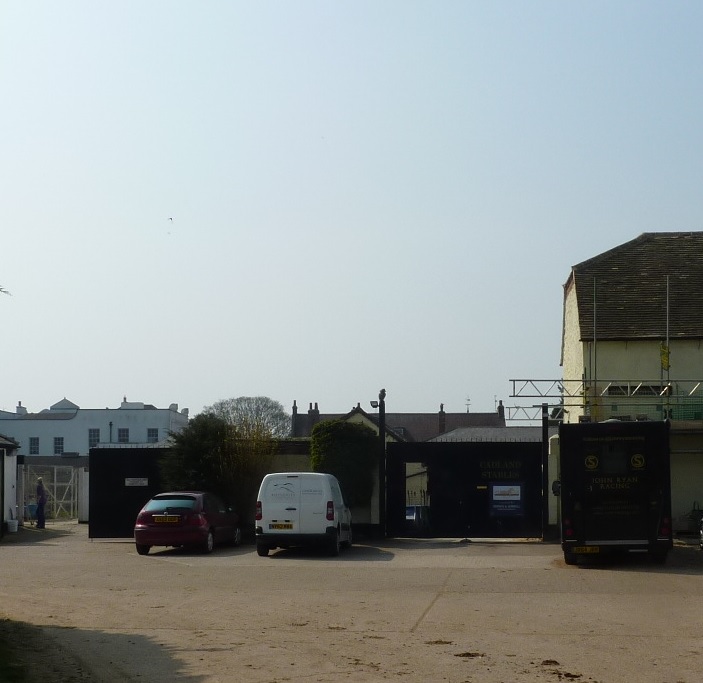
1978-October 2005 Michael (Mick) Ryan
Mick Ryan, son of Michael Ryan the former stud groom who took care of the great Hyperion, was apprentice at Stanley House Stables, now Godolphin, firstly for George Colling and later for Jack Watts. In order to gain further experience he travelled to the America, and became assistant trainer to Florence Nightingale Graham, better known as Elizabeth Arden after the cosmetics company she founded. Arden owned Main Chance Farm in Lexington, Kentucky, and prior to Mick's arrival she won the 1947 Kentucky Derby with Jet Pilot, ridden by Eric Guerin, and the 1954 Kentucky Oaks with Fascinator ridden by Anthony De Spirito. On his return to England in 1964 Mick returned to Stanley House Stables as assistant and travelling head lad to Bernard Van Cutsem. During his time assisting Van Cutsem there were a number of top class horses trained at Stanley House Stables, including Park Top, winner of the 1969 Coronation Cup and Hardwicke Stakes, Sharpen Up, winner of the 1971 Seaton Delaval Stakes and Middle Park Stakes, and High Top, winner of the 1971 Observer Gold Cup and 1972 2000 Guineas. Bernard Van Cutsem died on 8th December 1975, which served as a springboard for Mick to apply for his own trainer's licence. In 1976 he launched his training career at Hurworth House Stables, and went on to purchase Cadland House and Stables soon afterwards. He first began to make a name for himself by establishing long sequences of wins with horses, in 1979 with Boxberger Prins, Pink Tank and Jolimo, and in 1982 with Brady, although his most remarkable sequence was in 1998 with Lady Rockstar who won 8 consecutive races in 33 days between 28th March and 29th June 1998. One of his first big race successes was when Royale Heroine won the 1982 Princess Margaret Stakes at Ascot for M Sinclair and, before it ran again, was bought by Robert Sangster and transferred to Michael Stoute's Freemason Lodge stable.
However, the filly which really put Mick on the map resulted from a chance meeting at Yarmouth races with a confident, cocky, loud yet likeable Terry Ramsden, an expert on the Japanese warrants markets who liked to plunge just as deeply into the betting market whenever he fancied one of his horses. Ramsden bought a filly called Katies and sent it to Mick to be trained. The filly won the 1984 Irish 1000 Guineas, following up in the Coronation Stakes later that year. Ramsden also owned Motivator, the 15/2 winner of the 1986 Coral Golden Hurdle final at the Cheltenham Festival. Like many before him, the good times came to an abrupt end when the financial crash of 1987 wiped away his fortune, and, it is alleged, much more besides, but he was a character who did brighten the racecourse for his season. Mick had a further trick up his sleeve in 1998, sending Sweetness Herself to Ireland to win the Irish Cesarewitch, an unusual race to be won by an English trained horse. Mick continued to train until retirement beckoned in October 2005, allowing son John to begin his training career in a part of the Cadland Stables.
1982 Princess Margaret Stakes at Ascot ROYAL HEROINE owned by M Sinclair, trained by Mick Ryan and ridden by Philip Robinson
1984 Irish 1000 Guineas KATIES 20/1 (SR 1951) owned by Terry Ramsden, trained by Mick Ryan and ridden by Philip Robinson
1984 Coronation Stakes KATIES owned by Terry Ramsden, trained by Mick Ryan and ridden by Philip Robinson
1986 Coral Golden Hurdle Final at Cheltenham MOTIVATOR 15/2 fav owned by Terry Ramsden, trained by Mick Ryan and ridden by Graham McCourt
1987 Christmas Hurdle at Kempton OSRIC 12/1 trained by Mick Ryan and ridden by Graham McCourt
1998 Irish Cesarewitch SWEETNESS HERSELF 8/1 owned by Mrs M J Lavell, trained by Mick Ryan and ridden by Pat McCabe
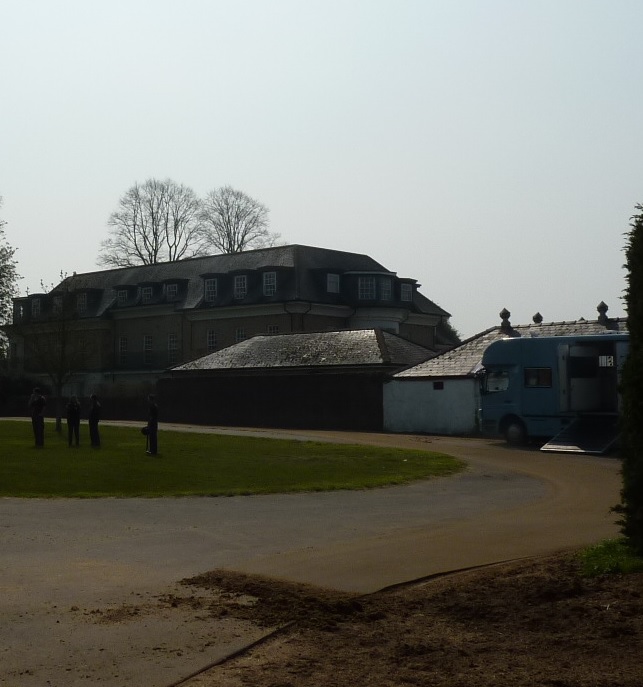
28th May 1998 won at Ayr won at 7/1
3rd June 1998 won at Folkestone won at 5/2
5th June 1998 won at Haydock won at 7/4
11th June 1998 won at Yarmouth won at 2/1
17th June 1998 won at Nottingham won at 11/10 fav
22nd June 1998 won at Windsor won at 11/10 fav
26th June 1998 won at Folkestone at 11/10 fav
29th June 1998 won at Windsor 6/4 fav
October 2005-2007 John Ryan
John Ryan, son of Cadland trainer Mick Ryan and grandson of Mick Ryan the stud groom who took care of Hyperion, was born in Newmarket on 3rd March 1968 and rode over the Flat and jumps. He piloted his first winner, Polynor, for father Mick at Southwell on 27th April 1987. He rode as a conditional jockey for National Hunt legend Stan Mellow, winning 174 races in his career. He retired from race riding in 1997 to begin the process of learning his trade as a trainer. He became assistant to Yogi Breisner, a well-known and respected lecturer in jump racing for the British Racing School in Newmarket, before moving on to assist Philip Mitchell at Epsom. He followed this with a period assisting his father, later gaining further experience assisting Jamie Poulton. When his father retired in October 2005 John felt the time was right to train in his own right, renting part of Cadland and racing under the banner of John Ryan Racing. When Gerard Butler, who also operated from Cadland in 2006, needed to expand and take over all of Cadland, John moved to Sackville House stables between 2008 and 2009, but then returned to Cadland House Stables in 2010.
2006-2009 Gerard Butler
When Mick Ryan retired in October 2005, he saw Cadland as his future nest-egg, renting part of the establishment to his son John, and the other part to Gerard Butler. For a period in 2008 and 2009 John moved to neighbouring Sackville House Stables, leaving the entire establishment to Gerard. Gerard Butler had learnt his trade from D Wayne Lukas, Colin Hayes and John Dunlop before, in 1998, he began training on his own account. Within a year he landed the biggest race of his career, winning the Coral Eclipse Stakes with Compton Admiral 20/1 owned by Erik Penser and ridden by Darryll Holland. He remained at Cadland until John Ryan returned in 2010.
2010-present John Ryan
After a spell at Sackville House, John Ryan returned to the family stable at Cadland and has enjoyed some success, particularly with Ocean Tempest in the 2014 Lincoln Handicap at 20/1. The colt notched up further successes in the Paradise Stakes at Ascot and the Royal Windsor Stakes. More recently, Grey Britain caused a 50/1 surprise in the Qatar Racing Handicap at Headquarters in the hands of Gerald Mosse.
2012 32Red Casino Handicap at Newmarket OCEAN TEMPEST 33/1 owned by W McCluskey and C Little, trained by John Ryan and ridden by Brett Doyle
2013 Innospec Handicap at Chester OCEAN TEMPEST 11/4 fav owned by W McCluskey and C Little, trained by John Ryan and ridden by Brett Doyle
2014 Lincoln Handicap OCEAN TEMPEST 20/1 owned by W McCluskey and C Little, trained by John Ryan and ridden by Adam Kirby
2014 Paradise Stakes at Ascot OCEAN TEMPEST 5/1 owned by W McCluskey and C Little, trained by John Ryan and ridden by Adam Kirby
2014 Royal Windsor Stakes OCEAN TEMPEST 5/4 fav owned by W McCluskey and C Little, trained by John Ryan and ridden by Adam Kirby
2018 Qatar Racing Handicap at Newmarket GREY BRITTAIN 50/1 owned by G Smith-Bernal and Alex Smith, trained by John Ryan and ridden by Gerald Mosse
January 2021-present Alice Haynes (Cadland Cottage Stables)
Alice Haynes joined the Newmarket training ranks in readiness for the 2021 season operating from Cadland Cottage stables.
WHALEBONE (1810 Epsom Derby)
CADLAND (1828 Epsom Derby, 2000 Guineas)
PASTILLE (1822 2000 Guineas, Epsom Oaks)
ZINC (1823 Epsom Oaks, 1000 Guineas)
KATIES (1984 Irish 1000 Guineas, Coronation Stakes)



